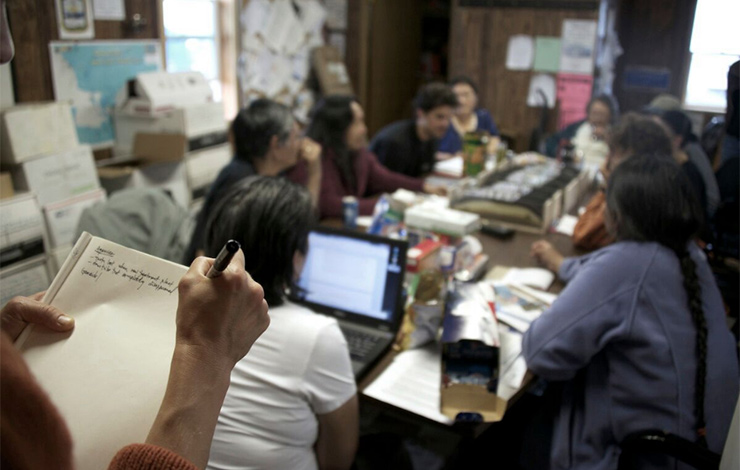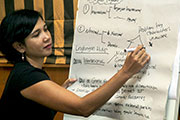Kivalina is an indigenous whaling community off the northwest coast of Alaska, whose future is threatened by rising sea levels. This program created a series of physical models representing the complex issues operating within the community, such as changing whale migration patterns, chemical dispersion in freshwater, and the historical migration of the Kivalina community.
Challenge

Kivalina is an indigenous whaling community situated off of the northwest coast of Alaska. Like many coastal communities, Kivalina's future is under threat from rising sea levels. The U.S. Government has ordered the village to relocate to higher ground within ten years, allocating a majority of the costs to the community. In 2008, Kivalina filed a lawsuit against 24 of the largest oil, gas, and electricity companies in the U.S. for knowingly emitting greenhouse gas emissions that contributed permafrost melt and coastal erosion in Kivalina, resulting in homes and buildings fallling into the sea. Kivalina sought damages to cover the cost of the village's relocation, which totaled up to $400 million. The Ninth Circuit Court of Appeals dismissed Kivalina v. ExxonMobil et al. in 2012, holding that the Clean Air Act (CAA) governs public nuisance global warming actions, even though the CAA does not include a provision for damages. As a result, the Court's decision leaves Kivalina without a legal remedy, despite imminent threats.
Program Summary
This project will initiate an urgent conversation around what a sustainable and secure environment for the people of Kivalina, and for indigenous peoples of the Arctic as a whole, might look like. The model functions as a tool to activate conversations around ongoing violations of the fundamental rights of indigenous people and ethnic minorities in the United States and the need to promote equal access to civil justice. The overal objective of the project "Modeling Kivalina" is: to create a series of physical models capable of representing the complex issues operating within the native whaling community of Kivalina, Alaska, with a goal to promote communication between multiple stakeholders. This will be accomplished through a research process that identifies the diverse set of environmnetal issues that shape the landscape in combination with an examination of the institutional protocols and practices that adjudicate over these issues. The project will produce these models in collaboration with different members of Kivalina's community. The assessment has already begun, by modeling changing whale migration patterns, chemical dispersion in freshwater, and the historical migration of the Kivalina community.
Impact
The impact of the project will be measured in two ways:
- Tracking and archiving research and outputs through a model design that will be developed and can successfully move between the various users who have stakes in the aforementioned issues. This archive, in tandem with the website, will ensure that the accumulated knowledge extends beyond the specific scope of the project. The project website will also function as a repository for bringing together different aspects of knowledge from the indigenous groups, government officials, lawyers, scientists, and other collaborators.
- The project will reproduce the model or versions of it for other institutions as well. In this way, the model will consistently serve as the central device through which the impact of the project is measured. Workshops will be documented, dialogues transcribed, and the visual documentation of the model's transformation recorded through photography and video. As Kivalina's community continues to fight for their fundamental rights and equal opportunity within the U.S. civil justice system, the model will offer an alternate means of communication, both amongst themselves and with the institutions that have control over the fate of their community. While the model will benefit individuals in Kivalina and contribute to the way that they understand the legal and political entangelment in which they are immersed, it will also be developed in such a way as to be transferable to similar situations where climate change and environmental issues pose a threat to cultural preservation.
Partners
Partners include:
- The Centre for Research Architecture;
- Goldsmiths University of London;
- Forensic Architecture;
- University of Washington; and
- ReLocate Kivalina

